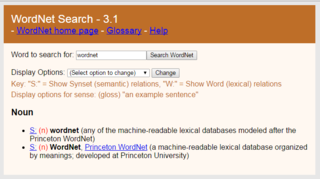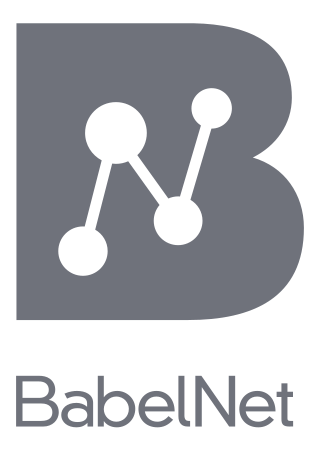Related Research Articles

WordNet is a lexical database of semantic relations between words in more than 200 languages. WordNet links words into semantic relations including synonyms, hyponyms, and meronyms. The synonyms are grouped into synsets with short definitions and usage examples. WordNet can thus be seen as a combination and extension of a dictionary and thesaurus. While it is accessible to human users via a web browser, its primary use is in automatic text analysis and artificial intelligence applications. WordNet was first created in the English language and the English WordNet database and software tools have been released under a BSD style license and are freely available for download from that WordNet website.
Word-sense disambiguation (WSD) is the process of identifying which sense of a word is meant in a sentence or other segment of context. In human language processing and cognition, it is usually subconscious/automatic but can often come to conscious attention when ambiguity impairs clarity of communication, given the pervasive polysemy in natural language. In computational linguistics, it is an open problem that affects other computer-related writing, such as discourse, improving relevance of search engines, anaphora resolution, coherence, and inference.

Wiktionary is a multilingual, web-based project to create a free content dictionary of terms in all natural languages and in a number of artificial languages. These entries may contain definitions, images for illustration, pronunciations, etymologies, inflections, usage examples, quotations, related terms, and translations of terms into other languages, among other features. It is collaboratively edited via a wiki. Its name is a portmanteau of the words wiki and dictionary. It is available in 186 languages and in Simple English. Like its sister project Wikipedia, Wiktionary is run by the Wikimedia Foundation, and is written collaboratively by volunteers, dubbed "Wiktionarians". Its wiki software, MediaWiki, allows almost anyone with access to the website to create and edit entries.
Semantic similarity is a metric defined over a set of documents or terms, where the idea of distance between items is based on the likeness of their meaning or semantic content as opposed to lexicographical similarity. These are mathematical tools used to estimate the strength of the semantic relationship between units of language, concepts or instances, through a numerical description obtained according to the comparison of information supporting their meaning or describing their nature. The term semantic similarity is often confused with semantic relatedness. Semantic relatedness includes any relation between two terms, while semantic similarity only includes "is a" relations. For example, "car" is similar to "bus", but is also related to "road" and "driving".
PropBank is a corpus that is annotated with verbal propositions and their arguments—a "proposition bank". Although "PropBank" refers to a specific corpus produced by Martha Palmer et al., the term propbank is also coming to be used as a common noun referring to any corpus that has been annotated with propositions and their arguments.
Linguistic categories include
Computational lexicology is a branch of computational linguistics, which is concerned with the use of computers in the study of lexicon. It has been more narrowly described by some scholars as the use of computers in the study of machine-readable dictionaries. It is distinguished from computational lexicography, which more properly would be the use of computers in the construction of dictionaries, though some researchers have used computational lexicography as synonymous.
Machine-readable dictionary (MRD) is a dictionary stored as machine (computer) data instead of being printed on paper. It is an electronic dictionary and lexical database.
Language resource management - Lexical markup framework, is the International Organization for Standardization ISO/TC37 standard for natural language processing (NLP) and machine-readable dictionary (MRD) lexicons. The scope is standardization of principles and methods relating to language resources in the contexts of multilingual communication.
In digital lexicography, natural language processing, and digital humanities, a lexical resource is a language resource consisting of data regarding the lexemes of the lexicon of one or more languages e.g., in the form of a database.
The Ubiquitous Knowledge Processing Lab is a research lab at the Department of Computer Science at the Technische Universität Darmstadt. It was founded in 2006 by Iryna Gurevych.
SemEval is an ongoing series of evaluations of computational semantic analysis systems; it evolved from the Senseval word sense evaluation series. The evaluations are intended to explore the nature of meaning in language. While meaning is intuitive to humans, transferring those intuitions to computational analysis has proved elusive.
GermaNet is a semantic network for the German language. It relates nouns, verbs, and adjectives semantically by grouping lexical units that express the same concept into synsets and by defining semantic relations between these synsets. GermaNet is free for academic use, after signing a license. GermaNet has much in common with the English WordNet and can be viewed as an on-line thesaurus or a light-weight ontology. GermaNet has been developed and maintained at the University of Tübingen since 1997 within the research group for General and Computational Linguistics. It has been integrated into the EuroWordNet, a multilingual lexical-semantic database.

BabelNet is a multilingual lexicalized semantic network and ontology developed at the NLP group of the Sapienza University of Rome. BabelNet was automatically created by linking Wikipedia to the most popular computational lexicon of the English language, WordNet. The integration is done using an automatic mapping and by filling in lexical gaps in resource-poor languages by using statistical machine translation. The result is an encyclopedic dictionary that provides concepts and named entities lexicalized in many languages and connected with large amounts of semantic relations. Additional lexicalizations and definitions are added by linking to free-license wordnets, OmegaWiki, the English Wiktionary, Wikidata, FrameNet, VerbNet and others. Similarly to WordNet, BabelNet groups words in different languages into sets of synonyms, called Babel synsets. For each Babel synset, BabelNet provides short definitions in many languages harvested from both WordNet and Wikipedia.
UBY is a large-scale lexical-semantic resource for natural language processing (NLP) developed at the Ubiquitous Knowledge Processing Lab (UKP) in the department of Computer Science of the Technische Universität Darmstadt . UBY is based on the ISO standard Lexical Markup Framework (LMF) and combines information from several expert-constructed and collaboratively constructed resources for English and German.
In natural language processing, linguistics, and neighboring fields, Linguistic Linked Open Data (LLOD) describes a method and an interdisciplinary community concerned with creating, sharing, and (re-)using language resources in accordance with Linked Data principles. The Linguistic Linked Open Data Cloud was conceived and is being maintained by the Open Linguistics Working Group (OWLG) of the Open Knowledge Foundation, but has been a point of focal activity for several W3C community groups, research projects, and infrastructure efforts since then.

Iryna Gurevych is a German computer scientist. She is Professor at the Department of Computer Science of the Technical University of Darmstadt and Director of Ubiquitous Knowledge Processing Lab.
OntoLex is the short name of a vocabulary for lexical resources in the web of data (OntoLex-Lemon) and the short name of the W3C community group that created it.
In linguistics and language technology, a language resource is a "[composition] of linguistic material used in the construction, improvement and/or evaluation of language processing applications, (...) in language and language-mediated research studies and applications."
Mona Talat Diab is a computer science professor at George Washington University and a research scientist with Facebook AI. Her research focuses on natural language processing, computational linguistics, cross lingual/multilingual processing, computational socio-pragmatics, Arabic language processing, and applied machine learning.
References
- ↑ Judith Eckle-Kohler, Iryna Gurevych, Silvana Hartmann, Michael Matuschek, Christian M Meyer: UBY-LMF - exploring the boundaries of language-independent lexicon models, in Gil Francopoulo, LMF Lexical Markup Framework, ISTE / Wiley 2013 ( ISBN 978-1-84821-430-9)
- ↑ Judith Eckle-Kohler, Iryna Gurevych, Silvana Hartmann, Michael Matuschek and Christian M. Meyer. UBY-LMF - A Uniform Model for Standardizing Heterogeneous Lexical-Semantic Resources in ISO-LMF. In: Nicoletta Calzolari and Khalid Choukri and Thierry Declerck and Mehmet Uğur Doğan and Bente Maegaard and Joseph Mariani and Jan Odijk and Stelios Piperidis: Proceedings of the 8th International Conference on Language Resources and Evaluation (LREC), p. 275--282, May 2012.
- ↑ Gottfried Herzog, Laurent Romary, Andreas Witt: Standards for Language Resources. Poster Presentation at the META-FORUM 2013 - META Exhibition, September 2013, Berlin, Germany.
- ↑ Laurent Romary: TEI and LMF crosswalks. CoRR abs/1301.2444 (2013)
- ↑ Iryna Gurevych, Judith Eckle-Kohler, Silvana Hartmann, Michael Matuschek, Christian M. Meyer, Christian Wirth: UBY – a large-scale unified lexical-semantic resource based on LMF, Proceedings of EACL, pp. 580–590, 2012, Avignon, France.
- ↑ Christian M. Meyer and Iryna Gurevych. What Psycholinguists Know About Chemistry: Aligning Wiktionary and WordNet for Increased Domain Coverage, in: Proceedings of the 5th International Joint Conference on Natural Language Processing (IJCNLP), p. 883–892, November 2011. Chiang Mai, Thailand.
- ↑ Silvana Hartmann and Iryna Gurevych. FrameNet on the Way to Babel: Creating a Bilingual FrameNet Using Wiktionary as Interlingual Connection. In: Proceedings of the 51st Annual Meeting of the Association for Computational Linguistics (ACL 2013), vol. 1, p. 1363-1373, Association for Computational Linguistics, August 2013.
- ↑ Michael Matuschek and Iryna Gurevych. Dijkstra-WSA: A Graph-Based Approach to Word Sense Alignment. In: Transactions of the Association for Computational Linguistics (TACL), vol. 1, p. 151-164, May 2013.
- ↑ John McCrae, Guadalupe Aguado-de-Cea, Paul Buitelaar, Philipp Cimiano, Thierry Declerck, Asunción Gómez-Pérez, Jorge Gracia, Laura Hollink, Elena Montiel-Ponsoda, Dennis Spohr, Tobias Wunner. (2012) Interchanging lexical resources on the Semantic Web. Language Resources and Evaluation 46:701–719.